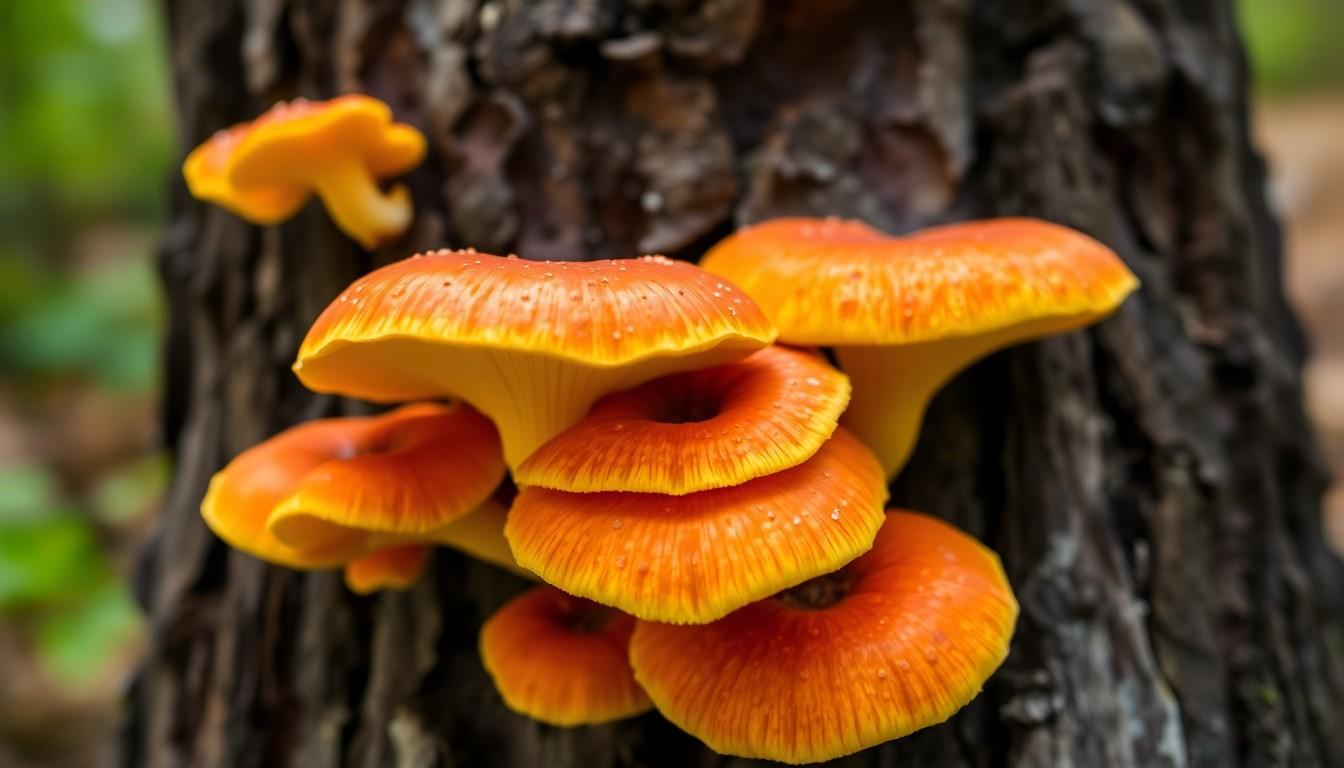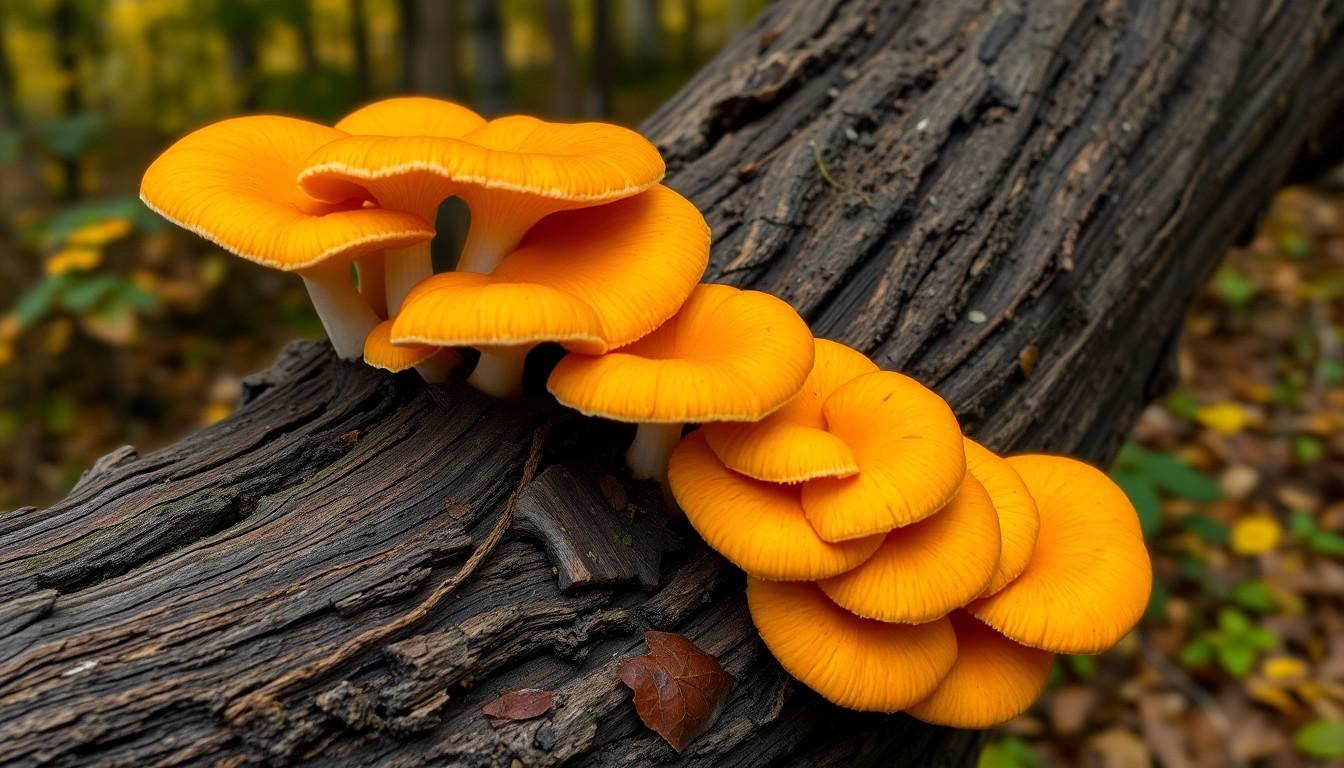Chicken of the Woods mushrooms have gained significant attention in the culinary world for their unique meat-like texture and impressive nutritional profile. This vibrant orange fungus, scientifically known as
Laetiporus sulphureus, grows on dead or dying trees and offers a sustainable, protein-rich alternative to conventional meat sources.
Nature’s bounty provides this remarkable mushroom with an array of
essential nutrients while keeping it low in calories. For health-conscious foragers and food enthusiasts, Chicken of the Woods presents an exciting opportunity to explore both traditional and modern cooking methods while reaping numerous nutritional benefits. From its protein content to its rich array of vitamins and minerals, this distinctive fungus continues to captivate both mycologists and nutritionists alike.
Chicken of the Woods Nutrition
Chicken of the Woods (Laetiporus sulphureus) is a bright orange polypore mushroom that grows in overlapping shelf-like clusters on dead or dying hardwood trees. The fungus appears from late spring through fall in North American temperate forests.
This distinctive mushroom earned its name from its meat-like texture similar to chicken breast when cooked. The brackets measure 2-12 inches wide with a thickness of 0.4-2 inches, creating fan-shaped shelves that cascade down tree trunks.
Key identifying features of Chicken of the Woods include:
-
- Vibrant orange-yellow upper surface
-
- Pale yellow pore surface underneath
-
- Soft spongy texture when young
-
- Annual growth pattern on host trees
Growth characteristics:
-
- Parasitic on living trees
-
- Common hosts: oak, cherry, beech
-
- Fruiting period: May to November
-
- Growth zones: Hardwood forests
| Feature |
Description |
| Scientific Name |
Laetiporus sulphureus |
| Size |
2-12 inches wide |
| Color |
Orange to yellow |
| Habitat |
Dead/dying hardwood trees |
| Season |
Late spring to fall |
The mushroom displays a shelf-like formation with multiple brackets growing in clusters. Fresh specimens have a velvety top surface texture that becomes harder with age. Each bracket produces millions of spores from tiny pores on the underside during its reproductive phase.
Nutritional Profile and Benefits
Chicken of the Woods mushrooms deliver exceptional nutritional value through their unique composition of proteins, vitamins, minerals, and bioactive compounds. These wild edible mushrooms provide a comprehensive array of nutrients while remaining low in calories.
Protein Content and Essential Amino Acids
Chicken of the Woods contains 21 grams of protein per 100 grams dry weight, making it one of the most protein-rich mushroom species. The mushroom’s protein profile includes all nine essential amino acids: histidine, isoleucine, leucine, lysine, methionine, phenylalanine, threonine, tryptophan, and valine. Its protein digestibility score reaches 85%, comparable to many animal-based protein sources.
Vitamins and Minerals
The mushroom’s nutrient density includes significant amounts of essential vitamins and minerals:
| Nutrient |
Amount per 100g (dry weight) |
| Potassium |
3,900 mg |
| Phosphorus |
780 mg |
| Magnesium |
160 mg |
| Vitamin D |
1,600 IU |
| Vitamin B3 |
5.8 mg |
| Iron |
9.1 mg |
Antioxidant Properties
-
- Phenolic acids: gallic acid, protocatechuic acid
-
- Flavonoids: quercetin, kaempferol
-
- Carotenoids: beta-carotene, lycopene
-
- Polysaccharides: beta-1,3-D-glucans, beta-1,6-D-glucans
Health Benefits of Chicken of the Woods
Chicken of the Woods mushrooms offer numerous health benefits through their bioactive compounds and nutrient composition. These benefits range from supporting immune function to promoting healthy weight management.
Immune System Support
The immune-boosting properties of Chicken of the Woods stem from its rich beta-glucan content and bioactive polysaccharides. These compounds enhance the activity of natural killer cells and macrophages, strengthening the body’s defense mechanisms. The mushroom’s high vitamin D content of 3.8 µg per 100g supports immune cell production and regulation.
| Immune-Boosting Components |
Amount per 100g |
| Beta-glucans |
15-25g |
| Vitamin D |
3.8 µg |
| Zinc |
3.5mg |
| Selenium |
2.6 µg |
Weight Management Benefits
Chicken of the Woods supports weight management through its low caloric density and high fiber content. Each 100g serving contains:
| Nutritional Component |
Amount per 100g |
| Calories |
35 |
| Dietary Fiber |
6g |
| Protein |
21g |
| Total Fat |
0.5g |
The mushroom’s high protein content increases satiety, while its dietary fiber promotes digestive health and helps maintain stable blood sugar levels. The low-fat content makes it an excellent meat substitute for calorie-conscious individuals.
How to Prepare and Store for Maximum Nutrition
Cleaning and Initial Preparation
Proper cleaning preserves the nutritional content of Chicken of the Woods mushrooms. Clean fresh specimens with a dry mushroom brush to remove debris. Pat gently with a damp paper towel for stubborn dirt, avoiding soaking which reduces nutrient retention. Trim away any tough or woody portions near the base.
Cooking Methods
Select cooking techniques that maximize nutrient preservation:
-
- Sauté in olive oil at medium heat for 8-10 minutes until golden brown
-
- Steam for 5-7 minutes to retain water-soluble vitamins
-
- Grill on medium-high heat for 4-5 minutes per side
-
- Bake at 375°F (190°C) for 15-20 minutes
Storage Guidelines
| Storage Method |
Temperature |
Duration |
Nutrition Retention |
| Fresh (refrigerated) |
34-38°F (1-3°C) |
5-7 days |
90-95% |
| Frozen |
0°F (-18°C) |
6 months |
80-85% |
| Dehydrated |
Room temp |
12 months |
70-75% |
Dehydration Process
Dehydration extends shelf life while maintaining nutritional value:
-
- Slice mushrooms into 1/4 inch strips
-
- Arrange on dehydrator trays with space between pieces
-
- Set temperature to 135°F (57°C)
-
- Dry for 4-6 hours until crisp
-
- Store in airtight containers away from light
Freezing Method
Freezing preserves nutrients effectively:
-
- Cut into serving-size portions
-
- Blanch for 3 minutes in boiling water
-
- Cool in ice bath for 3 minutes
-
- Package in freezer-safe containers
-
- Remove air before sealing
Rehydration Techniques
-
- Soak in warm water (110°F/43°C) for 20 minutes
-
- Use mushroom soaking liquid in cooking
-
- Pat dry before final preparation
-
- Consume within 24 hours of rehydration
Safety Considerations and Identification
Proper identification of Chicken of the Woods mushrooms requires attention to specific visual characteristics safety practices. Consuming wild mushrooms demands careful verification to prevent adverse reactions.
Key Identification Features
-
- Bright sulfur-yellow to orange shelves growing in overlapping clusters
-
- Pale yellow pore surface underneath with no gills or stems
-
- Fresh specimens feel soft spongy with a moisture content of 70-80%
-
- Growth exclusively on hardwood trees like oak cherry beech
-
- Annual appearance from May through November
-
- Size ranges from 2-20 inches wide per bracket
Location and Growth Patterns
-
- Found on living standing dead hardwood trees
-
- Never grows directly from the ground
-
- Forms shelf-like brackets at various heights on host trees
-
- Prefers eastern North American temperate forests
-
- Appears after spring rains when temperatures reach 65-75°F
-
- Multiple clusters can grow on a single tree host
Safety Precautions
-
- Avoid specimens growing on conifers eucalyptus or locust trees
-
- Harvest young tender brackets within 4-5 days of emergence
-
- Test a small portion (1-2 bites) during first consumption
-
- Wait 24 hours before eating larger amounts
-
- Skip specimens showing signs of decay or insect damage
-
- Collect from areas free of pesticides industrial pollution
Common Look-alikes
-
- Jack O’Lantern mushroom (Omphalotus olearius) – toxic orange gilled mushroom
-
- Berkeley’s Polypore (Bondarzewia berkeleyi) – larger tan-colored brackets
-
- Sulfur Shelf (Laetiporus cincinnatus) – white pore surface cream colored caps
-
- False Chicken of the Woods (Meripilus sumstinei) – dark brown black when bruised
Risk Factors
-
- Allergic reactions occur in 3% of consumers
-
- Gastrointestinal distress presents in sensitive individuals
-
- Raw consumption causes nausea digestive issues
-
- Cross-reactivity possible with shellfish allergies
-
- Mature specimens concentrate heavy metals from host trees
-
- Cooking reduces but doesn’t eliminate all risks
Harvest Guidelines
-
- Cut brackets 1 inch above attachment point
-
- Use clean sharp knife avoid tearing
-
- Transport in mesh breathable bags
-
- Process within 24 hours of collection
-
- Clean thoroughly before storage preparation
-
- Document collection location date for future reference
Storage methods
Chicken of the Woods stands out as a remarkable nutritional powerhouse in the world of wild mushrooms. Its impressive protein content paired with essential vitamins minerals and bioactive compounds makes it an excellent choice for health-conscious individuals and those seeking meat alternatives.
The mushroom’s versatility in cooking combined with proper storage methods ensures that everyone can enjoy its nutritional benefits year-round. While it’s important to follow safe foraging practices this edible fungus offers a sustainable and nutritious addition to any diet. Its unique combination of flavor texture and health-promoting properties truly makes it a valuable find in nature’s pantry.

